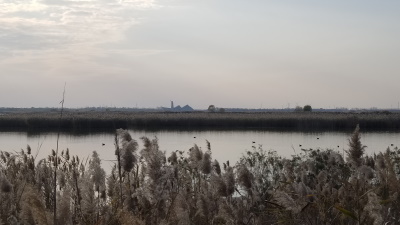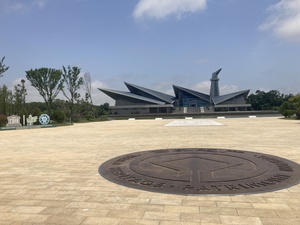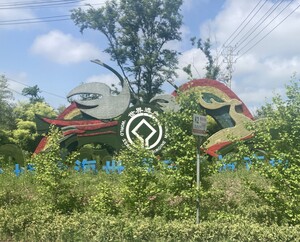Migratory Bird Sanctuaries China

The Migratory Bird Sanctuaries along the Coast of Yellow Sea - Bohai Gulf of China cover a mudflat system serving as bird foraging and resting areas.
The sanctuaries are part of the largest intertidal mudflat system in the world. Its habitats are crucial for the survival of migratory birds such as the Spoon-billed Sandpiper and Nordmann’s Greenshank.
Community Perspective: Zoë visited the "National Nature Reserve for Rare Birds" near Yancheng, a visitor center for the area, and advises to come in November (but she did see red-crowned cranes and Siberian cranes in September). Zos has gone into more detail about where the core zone starts around this reserve, while Els gave the latest update on getting there. Philipp tried to visit Chongming Dongtan Bird Habitat....
Map of Migratory Bird Sanctuaries China
Community Reviews
Philipp Peterer
This is my second non-visit review within a few months. I really hope this is not becoming a regular thing. I tried to visit the Chongming Dongtan Bird Habitat. Strictly looking at the map, this is by far the easiest place to visit, as it is very close to Shanghai.
I took a taxi from the center and left Shanghai at lunch time. The DiDi app predicted 1h50min to get there, which is 30min longer than Google Maps (with no access to any traffic information, because technically banned) told me, when I planned this at home. The price was predicted with around 40 EUR per way, which is not too bad for 2 hours driving. There are also no other options than taxi, so it’s that or you know someone who can drive you there.
Traffic was actually no issue within Shanghai, just the millions of traffic lights slow you down a bit. The real problem is following: there is only one connection between the mainland and Chongming island. And worst of all, it’s a toll way. About 5km from probably the toll booth, there was a crazy traffic jam. Not too crazy in terms of length. The drive could pass at least half of the line, before he sneaked in. The problem was, that the line basically did not move at all. After spending over an hour in the traffic jam, the driver made me understand that it would be almost dark until we arrived our destination. With a broken heart I abandoned and we drove back to the city. I am not sure, if I was just there at the wrong time or if this is a normal thing. I will try again, but opt for either early morning or late night to get there.
Els Slots

Like the other reviewers, I went to Yancheng for my ‘tick’ of the coastal Migratory Bird Sanctuaries. The visit starts at the iconic museum building, where it’s all about the cranes. The threatened red-crowned crane is the flagship species of the Reserve. The exhibition tells you about crane species all over the world and there is even a video shown of how to fold a paper crane. Another room shows the role cranes play in Chinese culture: it’s especially a Taoist symbol of longevity.
For my visit deeper into the Reserve, I had wanted to rent a golf cart so I could easily reach all corners of the area. However, despite considerable efforts by the guy renting them out, we could not make the full payment circle work with my Weixin Pay account. So I had to go on foot, which limited my radius of course (but the Reserve is not huge anyway). It turned out to be quite a pleasant walk and birds were everywhere, despite it being late in the season. The best chance to see its most famous visitors, the red-crowned cranes, apparently is December-January. I did scoure the sky for larger birds passing by and when looking at my pictures later on my laptop I saw that I had captured two cranes (of an unknown species) as well.
Smaller birds were plentiful on the ground and in the water. These all are common birds for the area, but still nice ones such as the Grey-headed lapwing and Greater scaup. There even is a whole island full of Common terns (Tern Island), which aggresively protect their turf (and offspring). They made a few mock charges towards my head while I walked by.
I completed the full ‘blue loop’ plus two detours a bit more towards the coast in about 2 hours. There are several bird hides along the way and there’s a nice boardwalk across the lake not far from the area where they keep captured cranes. Closer to the museum it all gets a bit more artifical, but overall they do succeed in letting nature be nature.
So where’s the core zone
I gave up trying to locate the core zone myself beforehand as the official maps are so unclear. What is clear though that it mostly comprises a strip of inaccessible mudflats right off the coast, with a few short diversions inland. After overlaying this with the map of the Reserve (lower photo) and consulting with Zos, I think it is where I have placed the yellow arrow pointing at. At the Reserve, they show the UNESCO WH logo everywhere and don’t care about buffer or core zones. The birds also don’t seem to mind.
Getting there and away
I was a bit surprised to not see the previous reviewers mention the train (the obvious choice of transport in China) for reaching Yancheng, but it turns out that this city only got connected to the high-speed rail network in 2019. Now it lies a 2-hour ride from Shanghai. You need to allocate a fair bit of time though for the ‘last mile’ to get to the reserve – I actually started from the airport (I flew in from Changsha) and took a Didi taxi for 130Y (16 EUR) which took 50 minutes. In the Didi app, the reserve is called ‘Yancheng Dandinghe Wetland Ecological Tourism‘. On the way back I took bus K2 to the railway station, which took 1h45 minutes! In hindsight, it would be best to leave the bus as soon as you’re entering the outskirts of the city and take a Didi directly for the remainder of the trip. On the plus side, buses are very frequent and cost only 7 Yuan (you can pay via the Alipay Transport City Bus option).
Read more from Els Slots here.
Zos M
Philippines/China - 04-Nov-19 -

Migratory Bird Sanctuaries (Yancheng Nature Reserve) [Visited 26 Oct, 2019]
It is tricky to plan a visit to this site. There are limited English information online. The detailed maps on the dossier shows three interpretation centers open for visitors (Yancheng Nature Reserve for Rare Birds, Dafeng Milu Nature Reserve, Tiaozini Scenic Area), but all in the buffer zones. Our Chinese fellow-WHS enthusiasts Wechat group also don’t know where and how to get to the core zones.
Only the middle section of Yancheng Nature Reserve is in the core zone. The Reserve for Rare Birds is completely in the buffer area but abuts the core on its northeast corner. Likewise, only the northeast section of Dafeng Milu Nature Reserve is in the core, the deer breeding center is way far from the inscribed area. And only one side of the Tiaozini Scenic Area abuts the core zone too.
My concrete plan was go to Yancheng and Dongtai and ask locals for specifics upon arriving. I dragged my Non-WHS seeking Taiwanese friend for a weekend trip to help me talk to the locals. It went well as expected. At the two interpretation centers I visited, I was able to see what gives the OUV and managed to walk into the core.
* Yancheng Nature Reserve for Rare Birds
Take bus K2 or K202 from Yancheng Coach Station or Yancheng Railway Station. It takes bit more than an hour since the buses run slow and numerous stops along the way.
This the primary tourist area of the WHS, where the well-photographed crane building is located. It seems tacky at first. But seeing it in the middle of the marsh, it builds up the anticipation upon entering and provides lasting impressing when leaving. It also acts as the anchor for visitors to not get lost while exploring the reeds.
The site is a hybrid between a zoo with cared birds for show and a wild nature reserve. They breed and take care of sick/injured the red-crowned crane here. So, you are always assured of seeing one of the iconic birds that gives the site OUV. At certain times of day, they let some to fly out, perfect for “instagrammable” shots.
The park is mostly reeds ponds and marches. There are camouflaged bird-watching tents scattered around to perfectly observe them without scaring them away. You can rent a bike (20 RMB per 2 hours) to go around the park. At the corner, in the core zone boundary, there is a road to the monitoring station inside the core zone. It is supposed to be for staff only, but I still went in. As of my visit, site-seeing tents going to the core zone are being built.
My visit was in mid-day. I only saw some birds in the park and in the core but there are lots of chirping. There seemed to be different species. At the best time of day, I can only imagine the flocks flying over. Birders for sure will enjoy this site. As for me, I felt wanting and decided to ensure I reach Tiaozini expecting the flocks to be there.
Zoë Sheng
Chinese-Canadian - 04-Oct-19 -

There was some confusion about where the places are until I checked the official map, and even now there is confusion. China news outlets reported the Dafeng Milu Nature Reserve to be included but actually it is not. There is an interesting history about that deer park (deer got eaten to extinction!!) and you do get to see many, many birds there but I am very sure it is not part of the inscription. My friend's family owns an eco lodge in a similar forest reserve in Jiangsu and you see many birds there of this caliber but they are obviously also not inscribed. To add to this, the entire "Yancheng Coast" is a bird paradise including several islands that are famous birdwatching destinations. China planned to inscribe many reserves/parks but ended up with just 2 to begin with - I'm guess to push the inscription through easier and add more later - but then again they do often just care about numbers so just having an inscription now doesn't mean they will prioritize extending it instead of grabbing a new +1.
Anyhow, there are 2 places near the town of Yancheng north of Shanghai and the only I chose to visit the site called "National Nature Reserve for Rare Birds". You can take a bus here from Shanghai (it's longer than you think) but I chose to fly to Yancheng instead. The flight is 1h from Hongqiao aiport. Upon arrival I took a taxi to the bus station for the K2 bus. There is a public bus from the airport to said bus station but I suspected it to take long. I only arrived at Yancheng at 2pm and the place I wanted to visit closes at 5 already. The K2 bus takes over an hour because the distance is still 40km. I made it to the reserve before 4pm. That might leave me with only 1h but I found it adequate for my kind of visiting. They didn't exactly kick me out at 5pm so I had 90 minutes in the park. If you are into birdwatching I understand you want to stay here longer for sure. The first striking thing you will see is the massive "crane" building, with the wings as roof and the head being a lookout tower!! Excellent idea.
After paying the 40 RMB I got to walk around on paths around the lakes. The red-crowned cranes are everywhere but they come in higher numbers in winter. I was told that September/October is the "best" time to visit but I think that's not necessarily true. There were many birds and the nature starts to become red-ish colors which some photographers totally dig, but the actual rare birds don't arrive from Siberia until it's dead cold up there. So perhaps November is the better time to go as it's still warm in the area and more birds have arrived. Other birds I saw was a Siberian crane, so yes they do come around this time! The main draw for birdwatchers are probably the tiny spoon-billed sandpipers because there are only a few dozen in the park at the most. They are not as cute as the one in the Pixar short but still a top sight because of their size and distinct bill. So, no, I didn't see one, and the picture is from a picture inside the building.
The area was already a Ramsar Wetland and a UNESCO Biosphere Reserve before joining the ranks of WHS. The added protection is supposed to help the wetlands. I disagree that adding another title will help that much but if they say so I'm fine with it. The biggest problem is not the bird poachers but the degrading of the land by China's new cities being built up nearby. Is that actually going to stop? Not in a hundred years. There are actually some cities on what used to be wetland and they are only a decade old. Basically some investment group came in, bought land (or leased for 99 years as it is official in China) and dumped a community of houses as per blueprint all around the country. I'm actually thinking that having a world heritage nearby makes them sell land even more!
To sum up I always like nature reserves but this one seems like an attempt to get tourists rather than protection. The sight is nice for the casual birdwatchers and serious ones alike. Best time to go still TBD maybe the hardcore birdwatchers will just go once a month lol
p.s. if you want me to fold you one of those cranes you'll need to fork out $49.99 +p&p ;)
Community Rating
Site Info
Site History
2024 Extended
To include 10 more locations
2024 Name change
From "Migratory Bird Sanctuaries along the Coast of Yellow Sea-Bohai Gulf of China (Phase I)" to "Migratory Bird Sanctuaries along the Coast of Yellow Sea-Bohai Gulf of China"
2021 Revision
Reappearance on T List under a new id number.
2019 Advisory Body overruled
IUCN advised Deferral
2019 Inscribed
Site Links
Unesco Website
Official Website
Locations
The site has 11 locations
Connections
The site has 16 connections
Ecology
Geography
Timeline
WHS Names
WHS on Other Lists
World Heritage Process
Visitors
21 Community Members have visited.
The Plaque
 (photo by Els)
(photo by Els) (photo by Els)
(photo by Els)